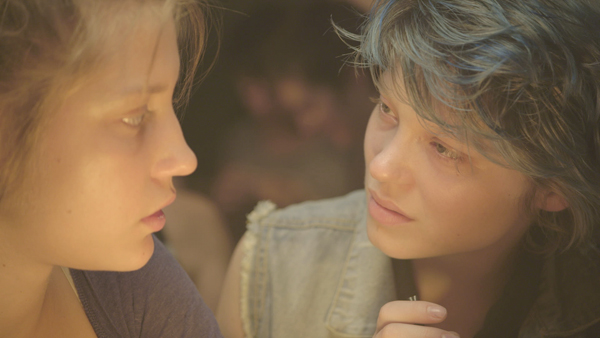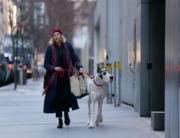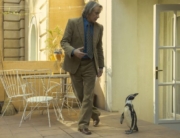Blue is the Warmest Color, the latest film by Abdellatif Kechiche, arrives in U.S. theaters some five months after its Palme d’Or win at this year’s Cannes Film Festival with an NC-17 rating and loads of unfortunately massive baggage attached. I won’t bore you (or myself) by rehashing the accusations and name-calling that has flown back and forth in the media between the director and his two lead actresses. Suffice it to say that the image of those three beaming faces, of Kechiche and actresses Adèle Exarchopoulous and Léa Seydoux, accepting their unprecedented joint win at Cannes seems now from almost another era.
The French title of Blue is the Warmest Color is “The Life of Adèle: Chapters 1 & 2,” and that’s exactly what this film is: scenes from the early years, from adolescence to young adulthood, of Adèle (Exarchopoulous), as she experiences intense and transformative experiences of life and love. The film is loosely adapted from Julie Maroh’s 2010 graphic novel of the same name, but a closer literary source is probably La Vie de Marianne, a novel by the 18th century French author Pierre de Marivaux.
Adèle identifies strongly with the protagonist and declares it her favorite novel. Kechiche is no stranger to Marivaux, or to using him as a direct inspiration. His 2003 film Games of Love and Chance set one of Marivaux’s comedies among a group of teens in a housing project in the Paris suburbs. La Vie de Marianne is a famously unfinished novel, and Kechiche’s new film is also in a sense unfinished as well. At the conclusion, after spending three hours in very close proximity with Adèle, it’s very clear that there will be much more to her story and that her journey is far from coming to an end.
Adèle acts just like any ordinary girl her age, hanging out with her friends at school, talking about boys. Adèle briefly goes out with the particularly handsome Thomas (Jérémie Laheurte), who seems to share a lot of her interests. Adèle, however, is left unfulfilled by their relationship; she seems to engage in sex with him more out of a sense of duty rather than from any passionate feeling.
The reason for this is brought home to her with the force of a lightning bolt when she has a chance meeting on the street with Emma (Seydoux), who has her arm around another woman. She locks eyes with Adèle for a brief but very intense moment. Adèle can’t get this blue-haired, vixen-eyed woman out of her head; she later masturbates while thinking about her. In short order, she breaks up with Thomas (although not without a remorseful crying jag afterward) and visits a lesbian bar, as if seeking confirmation for her previously unexplored attraction to women. Adèle, however, is rather turned off by the women who aggressively chat her up at the bar. Luckily, Emma comes to the rescue, and their very intense relationship begins in earnest.
This brings us to what has become the most notorious aspect of Blue: the sex scenes between Adèle and Emma, which convey the outsized passions between them. Even though the length of these scenes has been greatly exaggerated—they constitute between 15 and 20 minutes of the three hour running time—they are remarkable for their sustained intensity and explicitness for a mainstream film. Although they have been termed pornographic, they lack the clinical close-ups of true pornography. These scenes are fully in keeping with Kechiche’s aesthetic, which he has already established in his previous films. It’s an often messy and sprawling style which seeks to approximate the rhythms of everyday life and reject the carefully composed environments of most other directors. Here, it effectively portrays the sexual passion that both fuels their relationship and is a cause of its downfall.
Although the sex is very, very good, Adèle and Emma prove to have little in common. Adèle is from a lower-middle class background; Emma is older and comes from a more privileged family. Emma is ambitious about her art career, while Adèle’s work as a teacher’s assistant seems less important to her than living in devotion to Emma. Emma is proudly out, while Adèle remains closeted to her family and friends. In Adèle’s case, this seems less out of a sense of shame or fear of reprisal but more out of a desire to preserve her life with Emma as an intensely private experience. Yet their differences drive them apart, and the aftermath that plays out in the film’s latter scenes becomes quite heartbreaking. As great as both the actresses are, Exarchopoulous especially shines.
It’s such a great shame, then, that such a sensitively acted and passionately directed film has become mired in media controversy. The labeling and politicization that have been attached to the film’s sex scenes threaten to make them a spectacle rather than as an essential part of the film’s intensity and poignancy. Blue Is the Warmest Color is by no means a perfect film. Kechiche sometimes gets carried away with his camera’s proximity to the actresses, and it can come uncomfortably close to typical male-gaze voyeurism. But he succeeds far more often than he fails, and his film remains a remarkable achievement, one which deserves to be seen without the encumbrances of its extra baggage.

















Leave A Comment